Controlled heating and cooling of mixed conducting metal oxide materials
a technology of mixed conducting metal oxide and heating and cooling, which is applied in the direction of diaphragms, inorganic chemistry, cable/conductor manufacturing, etc., can solve the problems of failure of parts, increasing the difficulty of keeping the interior of parts in equilibrium, and few solutions have been proposed to solve this problem to date. , to achieve the effect of increasing the oxygen activity, reducing or increasing the temperature of oxygen-containing gas, and increasing the oxygen activity of oxygen-containing gas
- Summary
- Abstract
- Description
- Claims
- Application Information
AI Technical Summary
Benefits of technology
Problems solved by technology
Method used
Image
Examples
example 1
Preparation of Test Samples
[0117]Dense bars were prepared by uniaxially pressing powder of La0.4Sr0.6CoO3-δ, sintering at 1250° C. for 4 hours, and cooling to room temperature. The bars were machined to dimensions of 4 mm wide by 2.2 mm thick and 51.3 mm long. The bars then were annealed in air to remove any surfaces stresses caused by machining by heating to 1100° C. at 1° C. / min, cooling to 600° C. at 1° C. / min, and cooling to room temperature at 0.5° C. / min.
example 2
Cooling in Air
[0118]Six bars prepared in the manner of Example 1 were heated in air at 2° C. / min to 850° C., and cooled at 1° C. / min to ambient temperature. The oxygen partial pressure was maintained at 0.209 atm by flowing a small amount of air into the furnace. After cooling to room temperature, the flexural strength of the bars was measured at room temperature in a four point bending apparatus. Exemplary techniques for conducting this testing can be found in ASTM C1161-94. The average strength of the 6 bars was 39.8 MPa with a standard deviation of 12.6 MPa.
example 3
Isocompositional Cooling
[0119]Six bars prepared in the manner of Example 1 were heated inside a retort in air at 2° C. / min to 850° C., and cooled 1° C. / min to room temperature while controlling the oxygen partial pressure in the retort. For the temperature range of 850° C. to 600° C., the oxygen partial pressure was maintained at 0.209 atm by flowing a small amount of air into the retort. For the temperature range of 600° C. to room temperature, the oxygen partial pressure inside the retort was controlled to maintain a constant oxygen stoichiometry in the ceramic bars. The variation of oxygen partial pressure as a function of temperature, to maintain a constant equilibrium vacancy concentration, xv(T*,0.21), is given in the equation below:
[0120]ln(PO2)=EOx-4g(ɛt)(6xv(T*,0.21)-x)-TSOx-2RTln(xv(T*,0.21)1-xv(T*,0.21))-μO20(T)RT
where xv(T*,0.21) represents the isocompositional oxygen vacancy concentration to be held constant at isocompositional temperature, T*, and Po2 of 0....
PUM
| Property | Measurement | Unit |
|---|---|---|
| atomic number | aaaaa | aaaaa |
| thickness | aaaaa | aaaaa |
| thickness | aaaaa | aaaaa |
Abstract
Description
Claims
Application Information
 Login to View More
Login to View More - R&D
- Intellectual Property
- Life Sciences
- Materials
- Tech Scout
- Unparalleled Data Quality
- Higher Quality Content
- 60% Fewer Hallucinations
Browse by: Latest US Patents, China's latest patents, Technical Efficacy Thesaurus, Application Domain, Technology Topic, Popular Technical Reports.
© 2025 PatSnap. All rights reserved.Legal|Privacy policy|Modern Slavery Act Transparency Statement|Sitemap|About US| Contact US: help@patsnap.com



